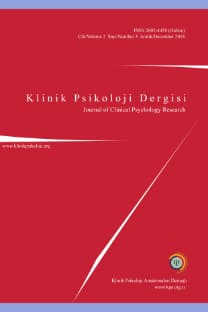Travma ile Başa Çıkabilme Algısı Ölçeğinin (TBÇA) Türkçeye uyarlanması, geçerlik ve güvenirlik çalışması
Perceived Ability to Cope with Trauma Scale (PACT): The Turkish adaptation, validity and reliability study
___
- Agaibi, C. E., ve Wilson, J. P. (2005). Trauma, PTSD, and resilience: A review of the literature. Trauma, Violence, ve Abuse, 6(3), 195-216.
- Amir, M., ve Sol, O. (1999). Psychological impact and prevalence of traumatic events in a student sample in Israel: The effect of multiple traumatic events and physical injury. Journal of Traumatic Stress, 12(1), 139-154.
- American Psychiatric Association. (2013). Diagnostic and statistical manual of mental disorders (5th ed.). Arlington, VA: American Psychiatric Publishing.
- Ataman, E. (2011). Stres veren yaşam olayları karşısında bilişsel duygu düzenleme stratejilerinin depresyon ve kaygı düzeyini belirlemedeki rolü. Yayımlanmamış Yüksek Lisans Tezi. Hacettepe Üniversitesi, Sosyal Bilimler Enstitüsü, Ankara.
- Block, J. ve Kremen, A. M. (1996). IQ and EgoResiliency: Conceptual and empirical connections and separateness, Journal of Personality and Social Psychology, 70(2), 349- 361.
- Bonanno, G. A., Pat-Horenczyk, R., ve Noll, J. (2011).
- Coping flexibility and trauma: The Perceived Ability to Cope With Trauma (PACT) scale. Psychological trauma: theory, research, practice and policy, 3(2), 117.
- Browne, M. W., ve Cudeck, R. (1993). Alternative Ways of Assessing Model Fit. In K. A.
- Briere, J., ve Scott, C. (2006). Principles of trauma therapy. A guide to symptoms, evaluation, and treatment. Thousand Oaks, CA: Sage.
- Büyüköztürk, Ş. (2007). Sosyal bilimler için veri analizi el kitabı. Ankara: Pegem Akademi Yayıncılık.
- De Vries, G. J., ve Olff, M. (2009). The lifetime prevalence of traumatic events and posttraumatic stress disorder in the Netherlands. Journal of traumatic stress, 22(4) 259-267.
- Eraslan, Ö. (2014). Üniversite öğrencilerinde psikolojik sağlamlık ile depresif belirtiler ve yaşam memnuniyeti arasındaki ilişkilerde benlik saygısı, pozitif dünya görüşü ve umudun aracılık rolünün sınanması. Yayımlanmamış Yüksek Lisans Tezi. Hacettepe Üniversitesi, Sosyal Bilimler Enstitüsü, Ankara.
- Foa, E. B., Cashman, L., Jaycox, L., ve Perry, K. (1997).
- The validation of a self-report measure of posttraumatic stress disorder: The Posttraumatic Diagnostic Scale. Psychological Assessment, 9(4), 445.
- Foa, E. B., ve Rothbaum, B. O. (1998). Treating the trauma of rape: Cognitive– behavioral therapy for PTSD. New York: Guilford Press.
- Franklin, C. L., ve Zimmerman, M. (2001). Posttraumatic stress disorder and major depressive disorder: Investigating the role of overlapping symptoms in diagnostic comorbidity. The Journal of nervous and mental disease, 189, 548 –551.
- Goleman, D. (1998). Duygusal zeka. İstanbul: Varlık.
- Grant, D. M., Beck, J. G., Marques, L., Palyo, S. A., ve Clapp, J. D. (2008). The structure of distress following trauma: Posttraumatic stress disorder, major depressive disorder, and generalized anxiety disorder. Journal of Abnormal Psychology, 117(3), 662.
- Herman, J. L. (1992). Trauma and recovery. New York: Basic Books.
- Horowitz, M., Wilner, N., ve Alvarez, W. (1979). Impact of Event Scale: a measure of subjective stress. Psychosomatic Medicine, 41(3), 209-218.
- Kağıtçıbaşı, Ç. (2017). Family, self, and human development across cultures: Theory and applications. Routledge.
- Karaırmak, Ö. (2007). Investigation of personal qualities contributing to psychological resilience among earthquake survivors: A model testing study. Yayımlanmamış doktora tezi. Orta Doğu Teknik Üniversitesi, Ankara.
- Karanci, N. A., Alkan, N., Aksit, B., Sucuoglu, H., ve Balta, E. (1999). Gender differences in psychological distress, coping, social support and related variables following the 1995 Dinar (Turkey) earthquake. North American Journal of Psychology, 1(2), 189.
- Karancı, A. N., Aker, T., Işıklı, S., Erkan, B. B. Gül, E., Yavuz, H. (2012). Türkiye‟de Travmatik Yaşam Olayları ve Ruhsal Etkileri. Kocaeli: Matus Basımevi.
- Kessler, R. C., Sonnega, A., Bromet, E., Hughes, M., ve Nelson, C. B. (1995). Posttraumatic stress disorder in the National Comorbidity Survey. Archives of General Psychiatry, 52, 1048 –1060.
- Kilpatrick, D. G., Resnick, H. S., Milanak, M. E., Miller, M. W., Keyes, K. M., ve Friedman,M. J. (2013). National estimates of exposure to traumatic events and PTSD prevalence using DSM‐IV and DSM‐5 criteria. Journal of Traumatic Stress, 26(5), 537-547.
- Kline R.B. (2005). Principles And Practice of Structural Equation Modeling. The Guilford Press.
- Kuppens, P., Realo, A., ve Diener, E. (2008). The role of positive and negative emotions in life satisfaction judgment across nations. Journal of Personality and Social Psychology, 95(1), 66.
- Lazarus, R. S., ve DeLongis, A. (1983). Psychological stress and coping in aging. American Psychologist, 38(3), 245.
- Lazarus, R. S. (1999). Stress and emotion: A new synthesis. New York, NY, US: Springer Publishing Company.
- Mikulincer, M., ve Shaver, P. R. (2012). An attachment perspective on psychopathology. World Psychiatry, 11(1), 11-15.
- O’Donnell, M. L., Creamer, M., ve Pattison, P. (2004). Posttraumatic stress disorder and depression following trauma: understanding comorbidity. American Journal of Psychiatry, 161(8), 1390-1396.
- Özkan, T., ve Lajunen, T. (2005). Masculinity, femininity, and the Bem sex role inventory in Turkey. Sex Roles, 52(1-2), 103-110.
- Salo, J. A., Qouta, S., ve Punamäki, R. L. (2005). Adult attachment, posttraumatic growth and negative emotions among former political prisoners. Anxiety Stress Coping, 18(4), 361-378.
- Schermelleh-Engel, K., Moosbrugger, H., ve Müller, H. (2003). Evaluating the fit of structural equation models: Tests of significance and descriptive goodness-offit measures. Methods of psychological research online, 8(2), 23-74.
- ISSN: 2602-4438
- Yayın Aralığı: 3
- Başlangıç: 2017
- Yayıncı: Klinik Psikoloji Araştırmaları Derneği
Yaşlı bireylerle yürütülen psikoloji uygulamalarına özgü etik meseleler
Özge KARABULUT, Özden YALÇINKAYA ALKAR
Yeme bozukluklarının etiyolojisinde ailesel faktörler: Güncel bir gözden geçirme
Burcu KÖMÜRCÜ, İpek ŞENKAL ERTÜRK
Types of environmental stressors and social support in bipolar disorder
Ayman SALEH, Kemal KUŞÇU, Kaan KORA
